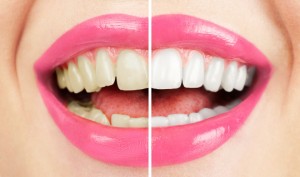3 Types of Tooth Stains and How To Fix Them
California Dental Group can help you enjoy a whiter, brighter smile

Superficial Stains
Dark liquids such as coffee, tea, red wine, or cola can leave a residue on your teeth that will make them look darker. The good news is that most of this residue is just trapped in the layer of plaque on the surface of your teeth. This means that if you act quickly, you can remove the discoloration simply by brushing your teeth with a whitening toothpaste. Be sure to read the toothpaste label carefully. You want a toothpaste that promises to polish away stains, not one with optic whiteners that merely cover stains to give the appearance of whiter teeth.
Embedded Stains
Over the years, surface stains can begin to penetrate deeper down into the tooth, causing the yellowing we associate with age. Habitual smoking or coffee-drinking, as well as poor oral hygiene in general, will make this happen faster. Once you have embedded stains on your teeth, they can only be lifted using some kind of bleaching agent.
While you can find plenty of at-home whitening products that contain peroxide for teeth bleaching, these products are not likely to provide the dramatic results you want. Instead, you need to get professional teeth whitening from California Dental Group. We use stronger bleaching agents than you can get over the counter, and because the treatment is done under the care of a dental professional the process is safe and comfortable. We recommend getting a dental cleaning before your whitening appointment to remove surface stains and maximize the effectiveness of the whitening treatment.
Structural Stains
Unfortunately, there are some types of stains that can never be bleached or polished away: structural stains. Common examples of structural stains include tetracycline stains (gray-brown stains caused by using the antibiotic tetracycline as a child) and fluorosis stains (white or brown stains caused by overexposure to fluoride.) Teeth may also appear gray or black if the tooth pulp is dead, though technically this is not a stain. If you have any of these kinds of structural stains, or if your embedded stains cannot be lightened to your satisfaction using whitening treatments, don’t worry. You can still get the white smile you want by covering your stained teeth with white porcelain veneers.
If you would like to learn more, we invite you to make an appointment with one of our experienced cosmetic dentists.




